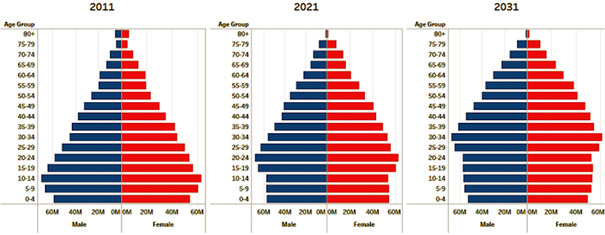Demographic dividend
The economic growth potential that can result from shifts in a country's age structure primarily when the working age population is larger than dependent population or the non-working population.
4/6/20252 min read
What is demographic dividend ?
Demographic dividend is the benefit arising from change is age structure of a country's population primarily when there is a rise in working age population (15-64) in the country, thereby boosting per capita income. This is typically brought on by decline in fertility and mortality rates.
It is experienced by countries that see decline in both fertility and mortality rates. As fewer births are registered, the number of young dependents grows smaller relative to working population. This frees up the resources of the economy with fewer people to support , and thus allows for more investments in other areas to accelerate a country's economic development and future prosperity of its populace.
It is not an overnight concept i.e a country must go through a demographic transition where it switches from a largely rural agrarian economy with high fertility and mortality rates to an urban industrial society with low fertility and mortality rates.
Demographic dividend in India
India has one of the youngest populations in the era of ageing population across the globe. It is believed that the median age of India will be around 28 years which is way lower than other developed nations like China and USA (45). Since 2018 , India's working age population has been growing larger than the dependent population , and this bulge is expected to last till 2025, or 37 years from its beginning.
The window of demographic dividend in India is available for 5 decades i.e from 2005-06 to 2055-56. This represents a way longer period than any other country in the world.
This demographic dividend window is available at different times in different states due to differential characteristics and behaviour of population.
Benefits associated with demographic dividend
Economic growth and prosperity :-
Increased labour force enhances the productive capacity of an economy
The resources can be diverted from spending on children to investing in other activities like creation of physical and human infrastructure , creating more fiscal space.
Women's participation rises that is naturally accompanied by reduced fertility rate , leading to a new source of growth
As per data a 15% growth has been observed in advanced countries due to demographic dividends.
Rapid industrialisation and urbanisation :- This is due to the fact that more number of people being added to the labor force will increase the demand for employment opportunities that will lead to more industries being set up as well as transition towards urban settings, thereby forcing higher economic activities.
Increase in workforce :- Nearly 65% of working age population exist in India , that makes it an economic superpower and provides an opportunity to the country to supply more than half of Asia's potential workforce over the coming decades.
Increased savings and capital formation :- Since working age is the prime age of spending , this also leads to increase in saving rate , thereby boosting investments in economy. Also with fewer dependents, individual tends to save more , that in turn leads to increased capital accumulation and investments.
Consumption led growth :- A larger working age population can lead to a larger base of consumers , that drives up the aggregate demand. As income rises people tend to spend more , which can further stimulate economic activity.
Other benefits :-
With fewer children per family , more resources can be allocated to each child in terms of better education, health care, thereby creating a more skilled and healthy workforce.
Helps in empowering women with their enhanced participation in workforce leading to social progress.




